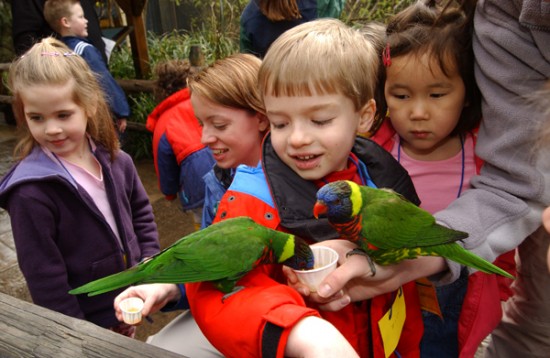Zoos are educational as they provide an opportunity to learn about different species and their habitats. In zoos, visitors can observe animals up close and engage in interactive exhibits, enhancing their understanding of wildlife and conservation efforts.
Additionally, zoos often offer educational programs and workshops, promoting environmental awareness and fostering a sense of responsibility towards the natural world. These experiences help cultivate a love for animals and the environment, prompting visitors to become stewards of conservation. Overall, zoos play a crucial role in educating the public about wildlife and fostering a deeper appreciation for nature’s diversity.

Credit: letshannondunk.com
Why Are Zoos Educational?
Why are Zoos Educational?
Zoos serve as interactive learning environments that offer valuable educational opportunities for visitors of all ages. One of the key educational aspects of zoos is their ability to enhance scientific knowledge through hands-on experiences and informative exhibits. By observing animals up close, visitors can learn about their natural behaviors, habitats, and adaptations. Zoos often provide educational programs and workshops that aim to engage visitors in interactive learning. These programs offer a deeper understanding of animal conservation efforts and promote awareness about the importance of protecting endangered species.
In addition to enhancing scientific knowledge, zoos also play a vital role in inspiring conservation awareness in visitors. Through educational signage and interpretive displays, zoos educate visitors about wildlife conservation, including the threats faced by various species and the efforts taken to protect them. Many zoos also collaborate with conservation organizations and participate in breeding programs to contribute to endangered species recovery.
Benefits For Children
Zoos are a valuable educational resource for children. They offer engaging and immersive learning experiences that can ignite a passion for the natural world. Through interactive exhibits and live animal encounters, children can get up close and personal with a variety of species, creating a deep and lasting connection. This sparks curiosity and interest in wildlife, encouraging children to ask questions and seek out further information.
Moreover, zoos play a crucial role in developing empathy and compassion towards animals. By observing their behavior and learning about their habitats, children gain a better understanding of the challenges animals face in the wild. This knowledge helps foster a sense of empathy, as they begin to realize the importance of conservation efforts and the need to protect endangered species.
In summary, zoos provide children with educational opportunities that go beyond textbooks and classrooms. They offer hands-on experiences that can inspire a love for nature and instill important values of empathy and conservation.
Zoos And Conservation Efforts
It is widely recognized that Zoos play a crucial role in educational and conservation efforts. One of the significant contributions of Zoos is their participation in breeding programs for endangered species. Through these programs, Zoos aim to protect and increase the population of endangered animals, thus preventing their extinction. Such initiatives help researchers in understanding animal behavior and habitats, which further aids in developing effective conservation strategies.
Zoos also play a vital role in raising awareness about conservation challenges and solutions. They provide educational exhibits and interactive displays to engage visitors and teach them about the importance of wildlife conservation. By showcasing the beauty and diversity of various animal species, Zoos inspire visitors to take action to protect the environment and support conservation efforts.
Overall, Zoos not only educate visitors about various animal species but also actively contribute to conservation initiatives. Their breeding programs, research efforts, and educational activities make them valuable institutions for promoting wildlife conservation and environmental sustainability.
Ethical Considerations
Why are Zoos Educational
Ethical Considerations
|
Subheadings under Ethical Considerations |
Ensuring proper care and enrichment for zoo animals |
Promoting ethical practices in captivity |
|
Balancing educational goals with animal welfare |
Zoo professionals prioritize the well-being of animals in their care. They invest significant efforts in providing proper care, nutrition, and medical attention to ensure the animals’ overall health. Enclosures are designed to mimic natural habitats as much as possible, with considerations for space, temperature, and enrichment. Enrichment activities such as puzzle feeders, toys, and social interactions are utilized to stimulate the animals mentally and physically. This helps promote their overall well-being and allows visitors to witness and learn more about natural animal behaviors. |
Zoos have increasingly focused on promoting ethical practices in captivity. They aim for conservation and education while respecting the animals’ rights and welfare. This includes avoiding practices that cause unnecessary distress or harm to the animals. Zoos work closely with conservation organizations and adhere to strict regulations to ensure the ethical treatment of animals. They also participate in breeding programs to maintain genetically diverse populations and potentially reintroduce species into their natural habitats. By providing educational programs and information, zoos seek to raise public awareness about the importance of conservation and animal welfare. |
Criticisms And Responses
Critics argue that zoo animals are confined in unnatural habitats, leading to psychological distress. However, zoos have made significant efforts to address these concerns. Modern zoo design and management aim to provide animals with environments that simulate their natural habitats as closely as possible. Enclosures are designed to replicate the animals’ natural habitats, incorporating vegetation, rocks, and water features. Zookeepers also strive to provide mental stimulation for the animals through various enrichment activities, such as puzzle feeders and toys.
To respond to the criticism of animal confinement, zoos have implemented educational programs to promote responsible visitor behavior. Visitors are encouraged to respect animals by not tapping on glass enclosures, throwing objects, or disturbing their resting times. By educating visitors about conservation, zoos hope to foster a sense of empathy and responsibility towards wildlife. Furthermore, zoos continually work on improving their facilities and practices. They collaborate with experts in animal behavior and welfare to ensure the well-being of the animals in their care.
| Criticisms | Responses |
|---|---|
| Animal confinement | Efforts in zoo design and management to provide natural habitats |
| Psychological effects | Enrichment activities to stimulate animals’ minds |
| Educational programs promoting responsible visitor behavior | |
| Continuous improvements in zoo facilities and practices |
Frequently Asked Questions Of Why Are Zoos Educational
How Much Do Zoos Educate People?
Zoos educate people by providing informative exhibits and interactive programs, fostering environmental awareness and conservation. Through close encounters with animals, visitors gain knowledge about different species, their habitats, and the importance of protecting biodiversity.
What Are 3 Benefits Of Zoos?
Zoos offer 3 benefits: conservation of endangered species, education for the public, and scientific research.
Why Are Zoos Educational For Kids?
Zoos are educational for kids through providing first-hand experiences with animals. Children learn about animal habitats, behavior, and conservation. Seeing the animals up close ignites curiosity and sparks an interest in wildlife. Zoos also offer educational programs and interactive exhibits, enhancing learning opportunities for children.
Are Zoos Educational Study?
Zoos are educational; they offer a chance to study various animals up close and learn about their habits and habitats.
Conclusion
Zoos play a crucial role in educating visitors about wildlife and conservation efforts. With interactive exhibits and informative signs, these institutions create a unique learning experience for both children and adults. By showcasing a wide range of animal species, zoos offer the opportunity to learn about biodiversity and ecosystems up close.
Seeing these creatures in person promotes empathy and a deeper understanding of the importance of their survival. Ultimately, zoos serve as valuable educational tools in fostering a connection between people and the natural world.







